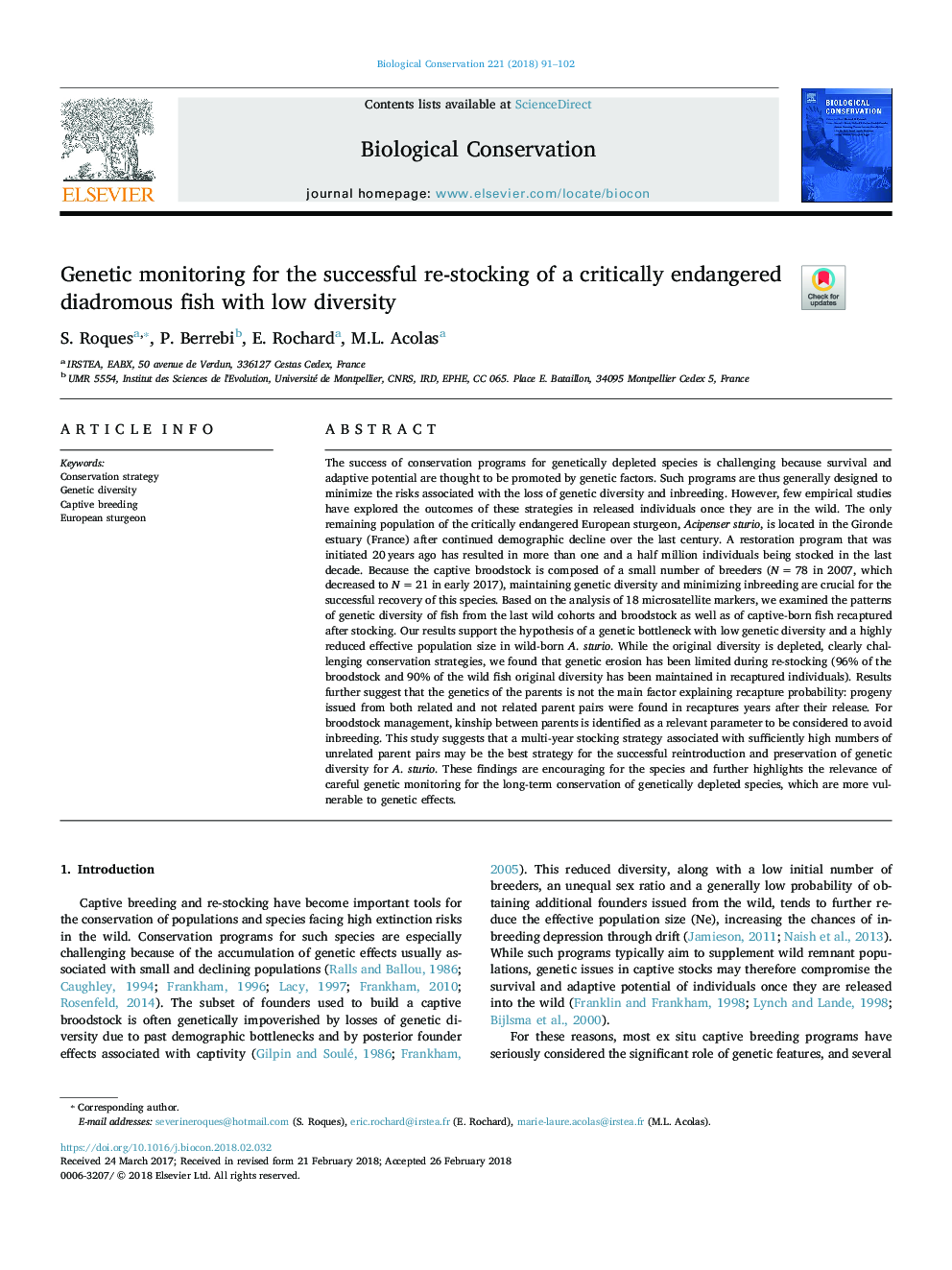| کد مقاله | کد نشریه | سال انتشار | مقاله انگلیسی | نسخه تمام متن |
|---|---|---|---|---|
| 8847307 | 1617884 | 2018 | 12 صفحه PDF | دانلود رایگان |
عنوان انگلیسی مقاله ISI
Genetic monitoring for the successful re-stocking of a critically endangered diadromous fish with low diversity
ترجمه فارسی عنوان
نظارت ژنتیکی برای ذخیره سازی مجدد ماهی هایی که به طور قابل ملاحظه ای خطرناک با تنوع کم هستند
دانلود مقاله + سفارش ترجمه
دانلود مقاله ISI انگلیسی
رایگان برای ایرانیان
کلمات کلیدی
استراتژی حفاظت، تنوع ژنتیکی، پرورش انفرادی، اروپایی ماهیان خاویاری،
موضوعات مرتبط
علوم زیستی و بیوفناوری
علوم کشاورزی و بیولوژیک
بوم شناسی، تکامل، رفتار و سامانه شناسی
چکیده انگلیسی
The success of conservation programs for genetically depleted species is challenging because survival and adaptive potential are thought to be promoted by genetic factors. Such programs are thus generally designed to minimize the risks associated with the loss of genetic diversity and inbreeding. However, few empirical studies have explored the outcomes of these strategies in released individuals once they are in the wild. The only remaining population of the critically endangered European sturgeon, Acipenser sturio, is located in the Gironde estuary (France) after continued demographic decline over the last century. A restoration program that was initiated 20â¯years ago has resulted in more than one and a half million individuals being stocked in the last decade. Because the captive broodstock is composed of a small number of breeders (Nâ¯=â¯78 in 2007, which decreased to Nâ¯=â¯21 in early 2017), maintaining genetic diversity and minimizing inbreeding are crucial for the successful recovery of this species. Based on the analysis of 18 microsatellite markers, we examined the patterns of genetic diversity of fish from the last wild cohorts and broodstock as well as of captive-born fish recaptured after stocking. Our results support the hypothesis of a genetic bottleneck with low genetic diversity and a highly reduced effective population size in wild-born A. sturio. While the original diversity is depleted, clearly challenging conservation strategies, we found that genetic erosion has been limited during re-stocking (96% of the broodstock and 90% of the wild fish original diversity has been maintained in recaptured individuals). Results further suggest that the genetics of the parents is not the main factor explaining recapture probability: progeny issued from both related and not related parent pairs were found in recaptures years after their release. For broodstock management, kinship between parents is identified as a relevant parameter to be considered to avoid inbreeding. This study suggests that a multi-year stocking strategy associated with sufficiently high numbers of unrelated parent pairs may be the best strategy for the successful reintroduction and preservation of genetic diversity for A. sturio. These findings are encouraging for the species and further highlights the relevance of careful genetic monitoring for the long-term conservation of genetically depleted species, which are more vulnerable to genetic effects.
ناشر
Database: Elsevier - ScienceDirect (ساینس دایرکت)
Journal: Biological Conservation - Volume 221, May 2018, Pages 91-102
Journal: Biological Conservation - Volume 221, May 2018, Pages 91-102
نویسندگان
S. Roques, P. Berrebi, E. Rochard, M.L. Acolas,
